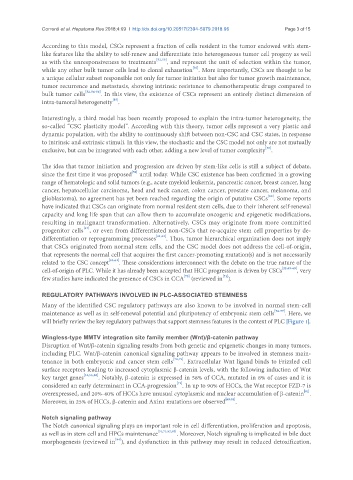Page 768 - Read Online
P. 768
Correnti et al. Hepatoma Res 2018;4:69 I http://dx.doi.org/10.20517/2394-5079.2018.96 Page 3 of 15
According to this model, CSCs represent a fraction of cells resident in the tumor endowed with stem-
like features like the ability to self-renew and differentiate into heterogeneous tumor cell progeny as well
as with the unresponsiveness to treatments [52,53] , and represent the unit of selection within the tumor,
[50]
while any other bulk tumor cells lead to clonal exhaustion . More importantly, CSCs are thought to be
a unique cellular subset responsible not only for tumor initiation but also for tumor growth maintenance,
tumor recurrence and metastasis, showing intrinsic resistance to chemotherapeutic drugs compared to
bulk tumor cells [52,54-56] . In this view, the existence of CSCs represent an entirely distinct dimension of
[57]
intra-tumoral heterogeneity .
Interestingly, a third model has been recently proposed to explain the intra-tumor heterogeneity, the
so-called “CSC plasticity model”. According with this theory, tumor cells represent a very plastic and
dynamic population, with the ability to continuously shift between non-CSC and CSC states, in response
to intrinsic and extrinsic stimuli. In this view, the stochastic and the CSC model not only are not mutually
[58]
exclusive, but can be integrated with each other, adding a new level of tumor complexity .
The idea that tumor initiation and progression are driven by stem-like cells is still a subject of debate,
[59]
since the first time it was proposed until today. While CSC existence has been confirmed in a growing
range of hematologic and solid tumors (e.g., acute myeloid leukemia, pancreatic cancer, breast cancer, lung
cancer, hepatocellular carcinoma, head and neck cancer, colon cancer, prostate cancer, melanoma, and
[60]
glioblastoma), no agreement has yet been reached regarding the origin of putative CSCs . Some reports
have indicated that CSCs can originate from normal resident stem cells, due to their inherent self-renewal
capacity and long life span that can allow them to accumulate oncogenic and epigenetic modifications,
resulting in malignant transformation. Alternatively, CSCs may originate from more committed
[47]
progenitor cells , or even from differentiated non-CSCs that re-acquire stem cell properties by de-
differentiation or reprogramming processes [61,62] . Thus, tumor hierarchical organization does not imply
that CSCs originated from normal stem cells, and the CSC model does not address the cell-of-origin,
that represents the normal cell that acquires the first cancer-promoting mutation(s) and is not necessarily
related to the CSC concept [63,64] . These considerations interconnect with the debate on the true nature of the
cell-of-origin of PLC. While it has already been accepted that HCC progression is driven by CSCs [22,65-69] , very
[71]
[70]
few studies have indicated the presence of CSCs in CCA (reviewed in ).
REGULATORY PATHWAYS INVOLVED IN PLC-ASSOCIATED STEMNESS
Many of the identified CSC regulatory pathways are also known to be involved in normal stem-cell
maintenance as well as in self-renewal potential and pluripotency of embryonic stem cells [72-77] . Here, we
will briefly review the key regulatory pathways that support stemness features in the context of PLC [Figure 1].
Wingless-type MMTV integration site family member (Wnt)/β-catenin pathway
Disruption of Wnt/β-catenin signaling results from both genetic and epigenetic changes in many tumors,
including PLC. Wnt/β-catenin canonical signaling pathway appears to be involved in stemness main-
tenance in both embryonic and cancer stem cells [78,79] . Extracellular Wnt ligand binds to Frizzled cell
surface receptors leading to increased cytoplasmic β-catenin levels, with the following induction of Wnt
key target genes [31,55,80] . Notably, β-catenin is expressed in 58% of CCA, mutated in 8% of cases and it is
[71]
considered an early determinant in CCA-progression . In up to 90% of HCCs, the Wnt receptor FZD-7 is
[81]
overexpressed, and 20%-40% of HCCs have unusual cytoplasmic and nuclear accumulation of β-catenin .
Moreover, in 25% of HCCs, β-catenin and Axin1 mutations are observed [69,81] .
Notch signaling pathway
The Notch canonical signaling plays an important role in cell differentiation, proliferation and apoptosis,
as well as in stem cell and HPCs maintenance [31,71,82,83] . Moreover, Notch signaling is implicated in bile duct
[84]
morphogenesis (reviewed in ), and dysfunction in this pathway may result in reduced detoxification,

